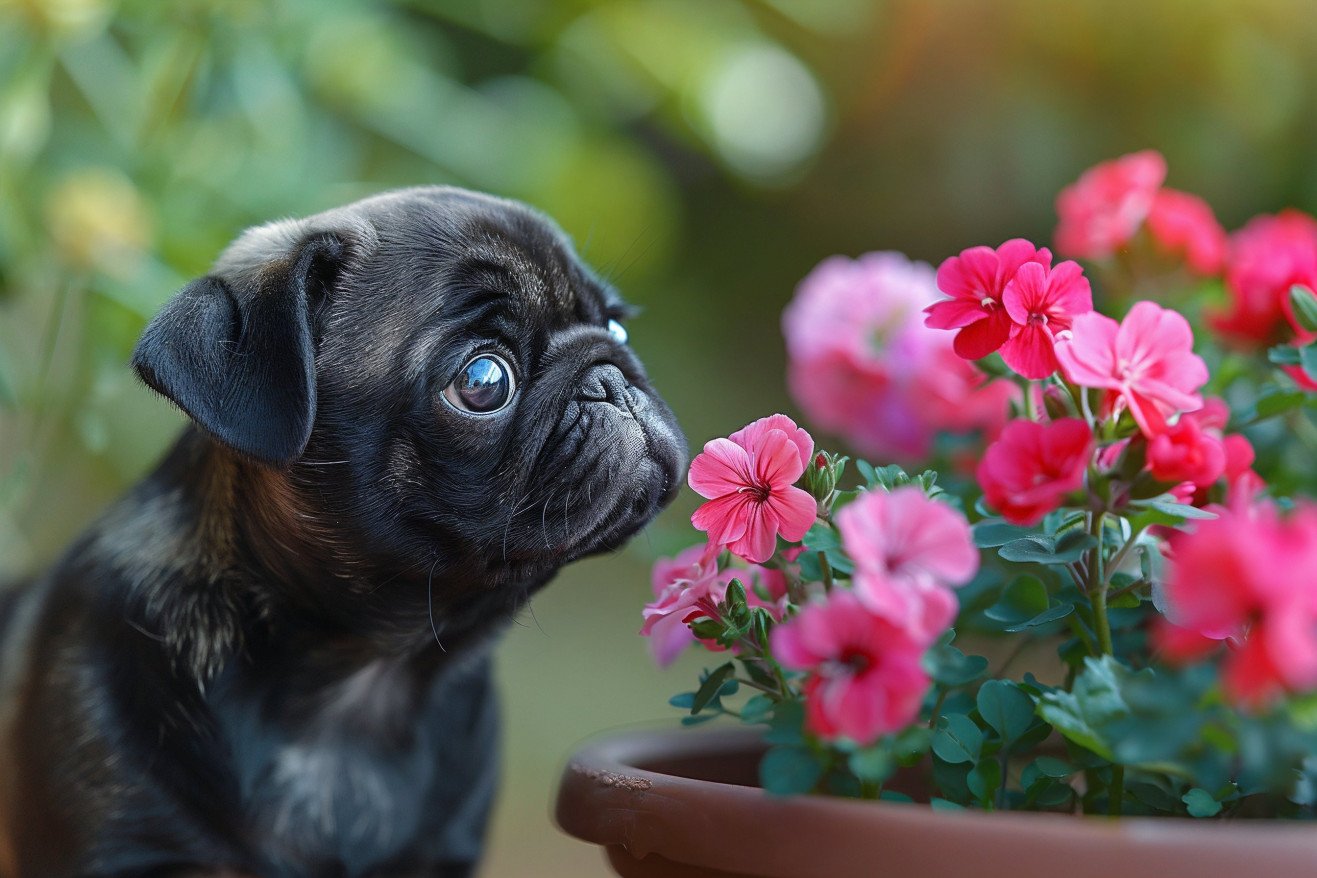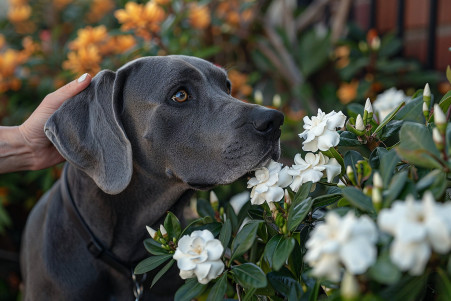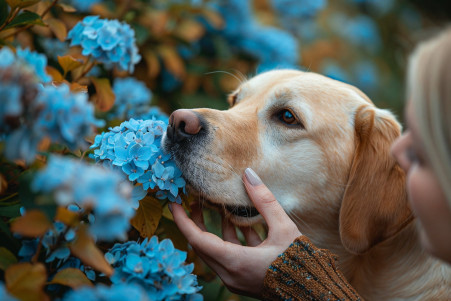Can Dogs Eat Geraniums? Everything You Need to Know
3 May 2024 • Updated 3 May 2024

If you have geraniums growing in your yard, you may be concerned about whether or not they can be toxic to your dog. Geraniums are considered to be mildly toxic to dogs. This is because the geranium plant contains chemicals such as linalool, geraniol, and citronellol, which can lead to symptoms like vomiting, lethargy, anorexia, depression, and dermatitis in dogs if they are ingested. While these symptoms aren't typically severe, it's still a good idea to prevent your dog from eating geraniums and to remove them from areas where your dog spends time.
To find out more about the dangers of dogs eating geraniums, as well as how dog owners can make sure their pets are safe, we'll take a look at information from veterinary toxicology research, cite dog care professionals, and learn from the experiences of dog owners. By the time you're done reading, you'll know exactly how much of a risk geraniums pose to dogs and what you can do to protect your furry friend.
Are geraniums poisonous to dogs?
Toxic Compounds and Symptoms of Geranium Poisoning
Geraniums produce several toxic compounds that can be harmful to our furry friends if they eat any part of the plant, including geraniol, linalool, and citronellol. If a dog eats a geranium, common symptoms to watch out for include vomiting, diarrhea, lethargy, depression, and skin irritation, according to veterinary toxicology studies.
The severity of these symptoms can depend on the amount of the plant that was eaten and the size and age of the dog. Smaller dogs and puppies are more likely to have severe reactions to even small amounts of geranium. In addition, the essential oils of scented geraniums are often more concentrated in toxic compounds, which can cause respiratory distress if inhaled or ingested.
Early signs that a dog has eaten a toxic amount of geranium include drooling, mouth and lip irritation, and gastrointestinal upset such as nausea or abdominal pain. These early symptoms can quickly progress to the more serious symptoms of vomiting, lethargy, and dermatitis listed above. If you think your dog has eaten any part of a geranium, especially a scented geranium, it's important to get them to the vet as soon as possible.
First Aid and Veterinary Care for Geranium Toxicity
If a dog has eaten geraniums, the first thing to do is to get rid of any plant material that is still in their mouth, notes Geranium-Leaf Aralia | Poisonous Plant For Pets. You can also give them small amounts of water or ice chips to help get rid of the toxins, according to the same article.
The next most important step is to call a vet or pet poison control hotline immediately to get professional advice, stresses My dog ate geranium leaves and flowers today and has thrown up and wants to eat anything and everything. Depending on the severity of the case, treatment can include vomiting, activated charcoal, and supportive care such as fluids and anti-nausea drugs, according to the same article.
It's important to keep a close eye on your pet since there is a risk of complications such as dehydration and organ damage, warns Ivy Geranium is Toxic to Dogs 🐶. However, with fast action and professional intervention, pet parents can help reduce these risks and ensure that their pet makes a full recovery.
Toxic Geranium Varieties and Plant Parts
Every part of the geranium plant is toxic to dogs, including the leaves, stems, and flowers, according to 26 Poisonous Plants to Dogs to Stay Away From | Purina. The Pelargonium genus, which includes scented geraniums, is especially dangerous because of its oils, according to Toxic plants.
Some geranium varieties are more toxic than others, with ivy geraniums and Martha Washington geraniums being especially dangerous, according to Martha Washington Geranium is Toxic to Dogs 🐶. However, it’s best to err on the side of caution and assume that all geraniums are toxic to dogs. Proper plant identification and keeping geraniums away from dogs are important for preventing toxicity.
Knowing which geranium varieties are most toxic and taking steps to limit dogs’ exposure to them can help dog owners keep their pets safe and free from harm.
How to Make a Dog-Friendly Garden: Safe Plant Options
If you want to make sure your garden is safe for your dog, you should avoid planting geraniums and other poisonous plants like chrysanthemums and daffodils, as suggested by 26 Poisonous Plants to Dogs to Stay Away From | Purina. Instead, Plants Safe for Dogs: Creating a Dog-Friendly Garden – Pawpedics recommends choosing non-toxic, hardy plants like camellias, rosemary, snapdragons, and nepeta (catmint).
These plants are hardy enough to withstand the occasional roughhousing and digging that dogs will subject them to, according to the same article. In addition, you can use solid paving stones or fencing to block off certain areas of the garden, as suggested by 12 Tips for a Dog-Friendly Garden | BBC Gardeners World Magazine. It's also important to make sure that dogs are well-trained and supervised so that they don't develop any bad habits in the garden, the article adds.
With a dog-friendly garden that includes safe, hardy plants, pet parents can enjoy a beautiful garden without worrying about the dangers of geraniums and other poisonous plants.
Conclusion: How to Protect Dogs From Geranium Toxicity
Geraniums, especially scented varieties, can be mildly to moderately toxic to dogs. Ingestion can result in vomiting, lethargy, skin irritation, and other symptoms that can be uncomfortable for dogs. If a dog has ingested a large amount of geraniums, it's best to seek veterinary care.
The best way to protect dogs from geranium toxicity is to avoid planting geraniums and choose other plants that are safe and non-toxic. According to the American Kennel Club, all types of geraniums are poisonous to dogs and can cause symptoms such as lethargy, hypotension, skin rashes, and anorexia.
If you're looking to create a dog-friendly garden, the Florissa guide suggests planting non-toxic perennials like coreopsis, coral bells, phlox, and kniphofia. It's also a good idea to choose plants that are well-established and strong enough to withstand some roughhousing from dogs. In addition, you can use fencing and solid paving to create barriers that can help keep dogs away from plants that may be toxic.
By taking these steps and planning your garden carefully, you can enjoy beautiful flowers without worrying about the potential dangers of geraniums and other toxic plants.


